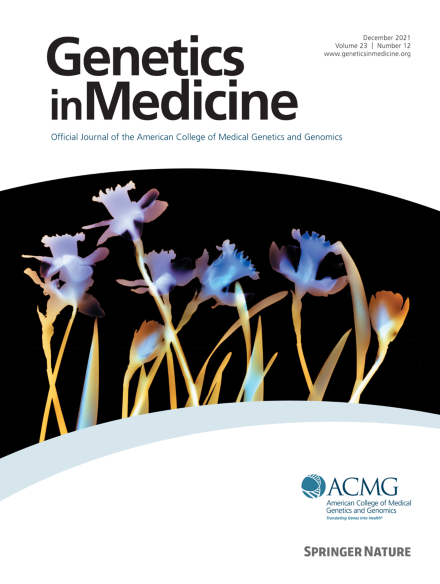利用基因组测序和群富集来支持马凡氏综合征剪接变异的解释。
IF 6.2
1区 医学
Q1 GENETICS & HEREDITY
引用次数: 0
摘要
目的:量化非典型FBN1剪接位点变异对未确诊马凡氏综合征(MFS)的影响,马凡氏综合征是一种与骨骼异常和家族性胸主动脉瘤病(FTAAD)相关的结缔组织疾病。方法:利用100,000基因组计划的基因组测序数据,对超罕见的FBN1变异进行系统分析。变体用SpliceAI进行注释,FTAAD个体间富集的意义使用Fisher精确检验进行评估。实验验证采用RNAseq、RT-PCR、minigene构建和复制分析,数据来自UK Biobank。结果:利用78195个个体的汇总数据,我们确定了FBN1中13864个单例snv,其中21个预计会影响剪接(SpliceAI >0.5)。与非FTAAD参与者相比,FTAAD招募个体的候选剪接变异发生率(9/703)显著升高(12/77,492;或= 84,p = 9.7 x10-14)。进一步的分析发现,另外14个家族拥有11种不同的FBN1剪接变体。在23个家族中共鉴定出20个候选剪接变异,其中70%位于±8个剪接区域之外。RNA检测证实了16/20的预期剪接异常,9/20的假外显子化是可能的剪接异常。结论:我们的研究结果表明,非典型剪接变异可能占未确诊FTAAD家庭的约3%,这突出了将内含子分析和确认性RNA检测纳入MFS基因检测的重要性。本文章由计算机程序翻译,如有差异,请以英文原文为准。
Utility of genome sequencing and group-enrichment to support splice variant interpretation in Marfan syndrome
Purpose
To quantify the impact of noncanonical FBN1 splice site variants in undiagnosed Marfan syndrome (MFS), a connective tissue disorder associated with skeletal abnormalities and familial thoracic aortic aneurysm disease (FTAAD).
Methods
A systematic analysis of ultrarare FBN1 variants was performed using genome sequencing data from the 100,000 Genomes Project. Variants were annotated with SpliceAI and the significance of enrichment among individuals with FTAAD was assessed using Fisher's exact test. Experimental validation used RNA sequencing, reverse transcriptase polymerase chain reaction, minigene constructs, and replication analysis was with data from UK Biobank.
Results
Using aggregate data for 78,195 individuals, we identified 13,864 singleton single-nucleotide variants in FBN1 of which 21 were predicted to affect splicing (SpliceAI > 0.5). Incidence of candidate splice variants in individuals recruited with FTAAD (9/703) was significantly elevated compared with that seen in non-FTAAD participants (12/77,492; odds ratio = 84, P = 9.7 × 10−14). Additional analysis uncovered a further 14 families harboring 11 different FBN1 splice variants. A total of 20 candidate splice variants in 23 families were identified, of which 70% lay beyond the ±8 splice regions. RNA testing confirmed the predicted splice aberration in 16 of 20 and for 9 of 20, pseudoexonization was the likely splicing anomaly.
Conclusion
Our findings indicate that noncanonical splice variants may account for approximately 3% of families with undiagnosed FTAAD, highlighting the importance of incorporating analysis of introns and confirmatory RNA testing into genetic testing for Marfan syndrome.
求助全文
通过发布文献求助,成功后即可免费获取论文全文。
去求助
来源期刊

Genetics in Medicine
医学-遗传学
CiteScore
15.20
自引率
6.80%
发文量
857
审稿时长
1.3 weeks
期刊介绍:
Genetics in Medicine (GIM) is the official journal of the American College of Medical Genetics and Genomics. The journal''s mission is to enhance the knowledge, understanding, and practice of medical genetics and genomics through publications in clinical and laboratory genetics and genomics, including ethical, legal, and social issues as well as public health.
GIM encourages research that combats racism, includes diverse populations and is written by authors from diverse and underrepresented backgrounds.
 求助内容:
求助内容: 应助结果提醒方式:
应助结果提醒方式:


